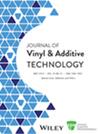Development of multifunctional passive cooling PE composites with high reflectivity and flame retardancy by combining inorganic flame retardant and organic aromatic compound
Abstract
In recent years, the pressing issue of energy problems has led to increased interest in passive cooling materials due to their energy-saving potential. In this work, antimony trioxide (Sb2O3) and decabromodiphenylethane (DBDPE) were added into polyethylene (PE) composites to obtain cooling materials with high reflectivity and flame retardancy. With 7 wt% Sb2O3 and 21 wt% DBDPE, the reflectance of samples in all solar wavelengths was greatly improved by at least 47.76%. Furthermore, the internal temperature of the self-designed temperature test device was reduced from 47.1 to 28.4 °C with a sunlight simulator at a light intensity of 1000 W/m2 for 1 h at an indoor temperature of 25 °C. In addition, the UL-94 vertical flammability rating was upgraded from No Rating to V-0, and the limiting oxygen index value increased by at least 6.2%. The selection of a PE matrix with a higher degree of crystallinity resulted in enhanced mechanical properties. These multifunctional PE composites have the advantage in its high reflectance across all solar wavelengths and relatively good flame retardancy. Evidently, resultant characteristics make these composites potential candidates for application in the passive cooling field.
Highlights
- Inorganic and organic particles were incorporated into the PE matrix.
- Multifunctional reflective cooling composites were prepared.
- The factors affecting the reflectivity of composites were analyzed.




 求助内容:
求助内容: 应助结果提醒方式:
应助结果提醒方式:


